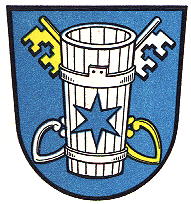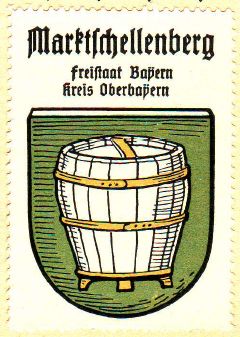Marktschellenberg: Difference between revisions
Knorrepoes (talk | contribs) (Created page with '{|width="100%" style="color:black; background-color:#ffffcc;" |width="15%"|50 px|left |width="70%" align="center" |'''Heraldry of the World<br/>Civic heraldr…') |
Knorrepoes (talk | contribs) No edit summary |
||
| Line 29: | Line 29: | ||
The present arms combine the salt barrel as a symbol for the salt mining, combined with the blue star. The two crossed keys behind the barrel are derived from the historical arms of the Berchtesgaden territory. | The present arms combine the salt barrel as a symbol for the salt mining, combined with the blue star. The two crossed keys behind the barrel are derived from the historical arms of the Berchtesgaden territory. | ||
{|align="center" | |||
|align="center"|[[File:marktschellenberg1.jpg|center]] <br/>The arms on a road sign | |||
|} | |||
[[Literature]] : Stadler, 1964-1971, 8 volumes; Hupp, O: [[Kaffee Hag albums]], 1920s | [[Literature]] : Stadler, 1964-1971, 8 volumes; Hupp, O: [[Kaffee Hag albums]], 1920s | ||
Revision as of 06:43, 18 October 2013
| Heraldry of the World Civic heraldry of Germany - Deutsche Wappen (Gemeindewappen/Kreiswappen) |
MARKTSCHELLENBERG
State : Bayern
District (Kreis) : Berchtesgadener Land (until 1973 Berchtesgaden)
Additions : 1969 Landschellenberg (1911 Ettenberg), Scheffau
Official blazon
In Blau eine mit einem sechsstrahligen blauen Stern belegte silberne Salzkufe, dahinter schräg gekreuzt ein goldener und ein silberner Schlüssel.
Origin/meaning
The arms were officially granted on March 12, 1964.
The arms are a combination of symbols taken from different older arms. As the city did not have its official arms, there were several different arms for the city used in the 19th and early 20th century.
From 1885 onwards a shield with only a blue star was mentioned as arms for the city. The star is most likely derived from the arms of the Counts of Gutrath, who owned the city for a long time. In 1896 a shield with in the upper half a lion, and in the lower half a series of salt miner's tools were mentioned.
In 1928 Hupp showed only a salt barrel (Salzkufe), without further reference to its origin, see below:
| The arms in the Kaffee Hag albums +/- 1925 |
The present arms combine the salt barrel as a symbol for the salt mining, combined with the blue star. The two crossed keys behind the barrel are derived from the historical arms of the Berchtesgaden territory.
| The arms on a road sign |
Literature : Stadler, 1964-1971, 8 volumes; Hupp, O: Kaffee Hag albums, 1920s


